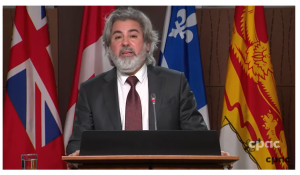A long-running series, filled with conflict, controversy, international intrigue and colourful personalities, has come to an end – and the top streaming services are facing a dilemma.
Don’t worry, viewers – The Diplomat is still on; you can still catch Echoes.
But Canada’s Bill C-11, the new Online Streaming Act, is now the law of the land. After literally years of heated debate, public commentary, and industry input, it finally updates the country’s long-standing Broadcasting Act.
“With this legislation, we are ensuring that Canada’s incredible talent has a bigger and brighter stage online,” Canadian Heritage Minister Pablo Rodriguez said.

New laws are designed to ensure streaming media companies “pay their fair share in supporting Canadian artists”, according to Canadian Heritage Minister Pablo Rodriguez. CPAC screen grab.
“They tell our stories, they make our voices heard, they contribute to our economy, and they make our culture what it is: strong, diverse and unique,” he added.
Now, top streaming services, like Disney+, Hulu, Netflix, and Prime Video, will be required to “pay their fair share in supporting Canadian artists” and “contribute to the creation and availability of Canadian stories and music” in a similar way that Canadian broadcasters have long been required to fund and produce Canadian content to meet certain standards and quotas.
A Canadian broadcaster’s operating license may depend on compliance with and approval by the CRTC; streaming media services have not faced any such requirement or regulation here, but in the European Union, a 30 per cent local content quota is in place – and most streamers meet or pass that threshold.
But now, if a streaming company operating here fails to follow the new Canadian law, folks at the country’s broadcast and telecom regulator, the Canadian Radio-television and Telecommunications Commission (CRTC), can levy fines and other penalties.

Popular streaming media companies will be mandated to support Canadian content online. MarketWatch image.
Either way, proponents of the new law eagerly predict the giant streaming platforms will “invest” millions of dollars in Canadian content and creators. Some streaming companies have already invested in CanCon for their own purposes; now such support can be mandated.
Opponents of the law have long worried it could stifle smaller independent content creators who cannot compete with major international services. Some even say the new law is a form of censorship, letting either government regulators or corporate bureaucrats determine which shows receive the production funding or the audience visibility they need to succeed.
In general, though, Canada’s media production community supports the bill, if only because the law had not been updated for more than 20 years.
“The modernization of Canada’s Broadcasting Act has been years in the making, and while the government’s stated goal of levelling the playing field has not yet been achieved, the bill contains many other positive elements that we applaud,” said Reynolds Mastin, President and CEO of the Canadian Media Producers Association.
“The bill enshrines critical provisions that ensure that producers can significantly and equitably benefit from their own stories,” the CMPA added. “This will foster a more inclusive broadcasting system that better reflects the needs and interests of all Canadians.”
The Canadian media advocacy group OpenMedia is not convinced. It says user generated content should not be regulated at all, and that viewer choice must not be infringed by legal quotas or funding requirements. “Make no mistake: the fight isn’t over yet,” said OpenMedia campaigns director Matt Hatfield.
Regulators seem pleased the bill is now law, but many have further steps to take. For example, Philippe Dufresne, the Privacy Commissioner of Canada, says he and his agency must ensure that privacy principles are incorporated when the CRTC exercises its new powers and incorporates the Bill C-11 amendments to the Broadcasting Act.
More than 100 amendments were made, considered, or incorporated by the government as the bill made its long way to royal assent. Privacy issues related to content discoverability and algorithmic recommendation engines, and protections for individual content creators are included with assurances that the bill “will not apply to user-generated digital content”.
Nevertheless, this show still ain’t over.
The CRTC will now have to create policy frameworks and action plans for implementing its new powers under Bill C-11. It will pay heed to a federal policy directive as well as a series of planned but as yet not announced consultations and proceedings with the general public, as well as digital creators, media businesses and other industry stakeholders.

Streaming media services and subscription video platforms are under intense scrutiny by governments and regulators around the world. Streaming media montage image: Ted O’Callahan, Yale University Press
It’s a continuing conversation, one that’s taking place both here in Canada and around the world.
In Australia, the government is planning to introduce media content quotas as part of its five-year plan to “revive national culture.”
The U.K. has been tightening rules on subscription video services, with new fines in place for those that violate privacy, accuracy or fairness principles.
As hard as some say it is to truly determine what is or is not ‘Canadian content’, the task seems much easier than determining what content is ‘fair’ – but stay tuned, as they say, and watch for the chance to have your vote on this continuing reality show.
-30-



